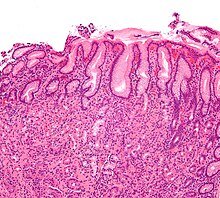Gastroenteritis
content of this page
1- Introduction
2- Pathophysiology
3- Symptoms
4- Treatment
Introduction
Gastroenteritis, often referred to as stomach flu or stomach bug, is an inflammation of the gastrointestinal tract. It commonly involves symptoms such as diarrhea, vomiting, abdominal cramps, and sometimes fever. Gastroenteritis can be caused by viral infections, such as norovirus or rotavirus, bacterial infections like Salmonella or E. coli, or parasitic infections. It spreads through contaminated food or water, close contact with infected individuals, or touching contaminated surfaces. While it can be uncomfortable, gastroenteritis is usually self-limiting and resolves within a few days with rest, hydration, and occasionally, symptomatic treatment. Severe cases may require medical attention to prevent dehydration or treat underlying infections.

Pathophysiology
The pathophysiology of gastroenteritis involves the inflammation of the gastrointestinal tract, typically triggered by infections from various pathogens including viruses, bacteria, and parasites. These microorganisms enter the body through contaminated food, water, or contact with infected individuals or surfaces. Once inside the gastrointestinal tract, they adhere to and invade the lining of the stomach and intestines, leading to disruption of normal cellular functions and the induction of an inflammatory response.
Viral gastroenteritis, often caused by viruses like norovirus, rotavirus, or adenovirus, primarily affects the lining of the small intestine. Viruses infect and destroy the cells lining the intestinal walls, disrupting the absorption of water and nutrients and causing increased fluid secretion into the gut. This results in watery diarrhea, a hallmark symptom of viral gastroenteritis. Vomiting may occur due to the irritation of the stomach lining by viral particles.
Bacterial gastroenteritis, caused by pathogens such as Salmonella, Escherichia coli (E. coli), Campylobacter, or Shigella, involves several mechanisms. Bacteria may produce toxins that directly damage intestinal cells, leading to inflammation and increased fluid secretion into the intestines. Some bacteria invade the cells of the intestinal lining, causing cell death and disrupting the normal absorption and transport functions of the intestine. This can result in diarrhea, which may be bloody in cases like Shigella infection, along with abdominal cramps and fever.
Parasitic gastroenteritis, caused by parasites like Giardia lamblia or Cryptosporidium, typically involves the invasion of the intestinal lining by the parasites themselves. Parasites may attach to the surface of intestinal cells, causing inflammation and disrupting the absorption of nutrients and water. This leads to symptoms similar to viral and bacterial gastroenteritis, including diarrhea, abdominal pain, and sometimes fever.
In all forms of gastroenteritis, the body’s immune response plays a significant role in combating the infection and clearing the pathogens.

Symptoms
Diarrhea: Watery or loose stools are a hallmark symptom, often accompanied by increased frequency of bowel movements.
Vomiting: Nausea and vomiting may occur, especially in viral gastroenteritis or cases involving toxins from bacteria.
Abdominal Pain: Cramping or discomfort in the abdomen, often due to intestinal spasms or inflammation.
Fever: Some infections, particularly bacterial gastroenteritis, can cause a low-grade fever or higher temperatures.
Dehydration: Signs of dehydration can include dry mouth, increased thirst, decreased urine output, and lightheadedness.
Loss of Appetite: Reduced desire to eat due to nausea, discomfort, or as a natural response to infection.
Fatigue: Feeling tired or weak, which can result from dehydration and the body’s efforts to fight the infection.
Muscle Aches: Generalized body aches or discomfort may accompany viral infections like norovirus.
Bloody Stools: In some cases, especially with bacterial infections like Shigella or certain strains of E. coli, stools may contain blood.
Headache: Mild to moderate headaches can occur, often due to dehydration or as a secondary symptom of the infection.
Treatment
1. Fluid Replacement:
- Oral Rehydration Solutions (ORS): Drinking ORS solutions helps replace lost fluids and electrolytes due to diarrhea and vomiting. These solutions contain balanced amounts of salts (sodium and potassium) and sugars to facilitate absorption.
- Clear Fluids: Clear broths, diluted fruit juices (without added sugar), and electrolyte drinks (e.g., sports drinks) can also help maintain hydration.
2. Diet and Nutrition:
- Gradual Reintroduction of Foods: Once vomiting has subsided, reintroduce bland, easy-to-digest foods such as bananas, rice, applesauce, and toast (BRAT diet).
- Avoid Certain Foods: Avoid dairy, fatty foods, caffeine, and spicy foods until symptoms improve.
3. Symptomatic Relief:
- Antiemetics: Medications to alleviate nausea and vomiting may be prescribed in severe cases or when symptoms are particularly distressing.
- Antidiarrheal Medications: These are generally avoided in bacterial or parasitic infections as they can prolong the infection by preventing the body from clearing the pathogen.
4. Antibiotics:
- Bacterial Infections: If bacterial gastroenteritis is diagnosed or suspected based on symptoms and tests, antibiotics may be prescribed. This is typically reserved for severe cases, immunocompromised individuals, or cases caused by specific bacteria like Salmonella or Shigella.
5. Supportive Care:
- Rest: Allow the body time to recover with adequate rest.
- Personal Hygiene: Practice good hygiene, including frequent handwashing, to prevent spreading the infection to others.
6. Medical Monitoring:
- Medical Evaluation: Seek medical attention if symptoms are severe, persistent, or worsen despite home care.
- Monitoring for Dehydration: Watch for signs of dehydration, especially in young children, older adults, or individuals with chronic illnesses.
Prevention:
- Hand Hygiene: Wash hands thoroughly with soap and water, especially after using the toilet and before handling food.
- Food Safety: Practice proper food handling, cooking, and storage techniques to prevent contamination.
- Vaccination: Vaccines are available for certain types of viral gastroenteritis, such as rotavirus.